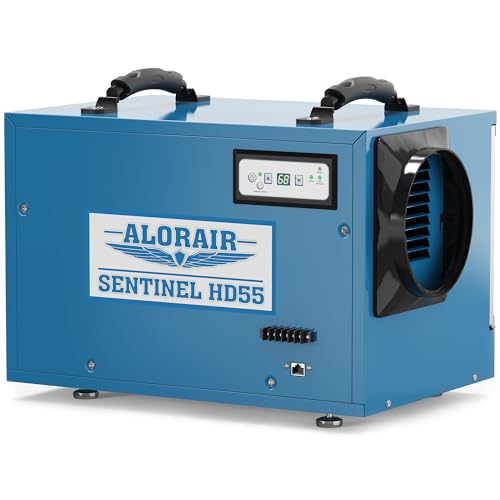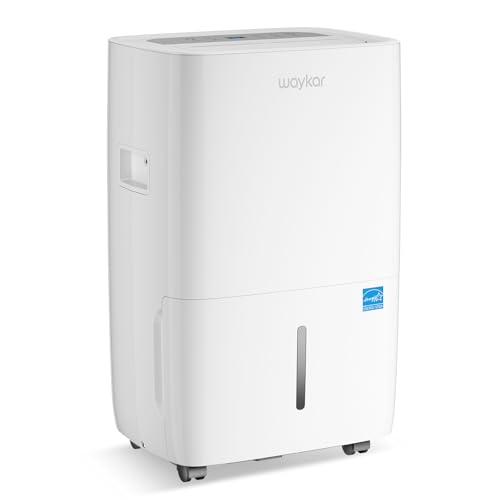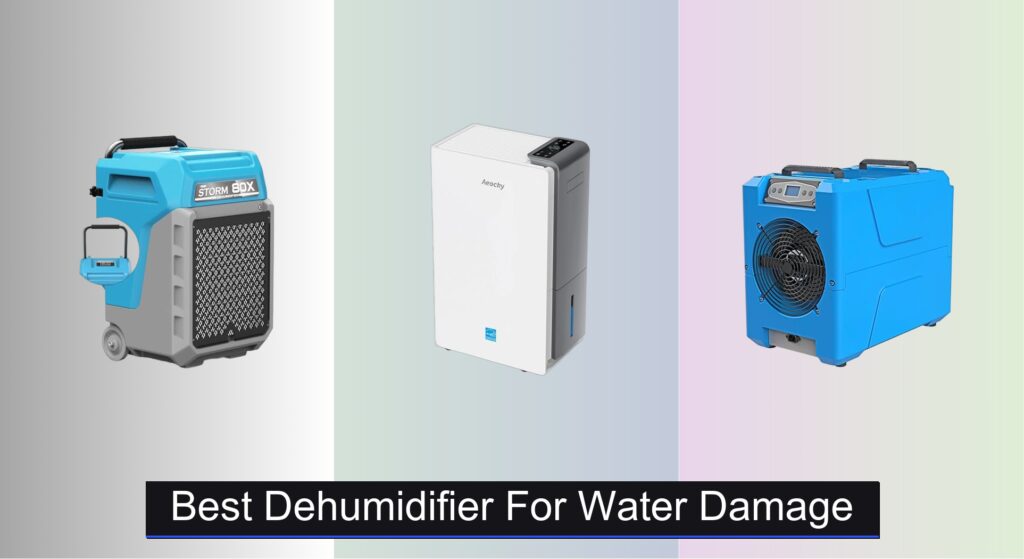Water damage can strike unexpectedly, leaving behind dampness that fosters mold, weakens structures, and compromises indoor air quality. Homeowners and restoration professionals alike need a powerful, reliable solution to remove moisture quickly and efficiently—especially in basements, crawl spaces, or flood-affected areas where standing water and high humidity linger. The right dehumidifier not only speeds up drying but also prevents long-term damage and health risks.
We analyzed over 50 dehumidifiers, focusing on pint capacity, drainage options, and performance in real-world water damage scenarios to identify the best models for rapid moisture removal. Our top picks balance power, coverage, and durability—prioritizing units with built-in pumps, high-efficiency compressors, and robust warranties. From compact crawlspace units to heavy-duty 180-pint workhorses, these dehumidifiers deliver proven results when you need them most. Keep reading to discover the best dehumidifier for water damage to protect your home and restore it faster.
Best Options at a Glance

ALORAIR 170 Pint Commercial Dehumidifier
Best Overall
- 170 pints/day
- 2,100 sq.ft
- Pump & hose
- Wheels & handle
- 5 years

AEOCKY 80 Pint Energy Star Dehumidifier
Best Energy Efficient
- 4500 sq.ft
- 80/56 pint/day
- 2025 Most Efficient
- 44dB
- Auto-drain with hose

MOUNTO 150 Pint Commercial Dehumidifier
Best for Large Water Damage
- 150 pints/day
- Panasonic
- Yes
- Pump with hose
- 25 ft

ALORAIR 180 PPD LGR Dehumidifier
Best High-Capacity Performance
- 180 PPD
- 85 PPD
- 210 CFM
- 22.8″L x 13.7″W x 17.3″H
- 5-Year Limited

Airecoler 125 Pint Commercial Dehumidifier
Best Value for Money
- 125 pints/day (Max)
- up to 6,000 sq ft
- 19.2″L*12.2″W*13.4″H
- Auto drain with hose
- 5-year covered

ALORAIR Sentinel HD55 113 Pint
Best for Crawl Spaces
- 113 PPD
- 1,200 sq.ft
- Continuous(hose)
- Auto Defrost
- 5 Years

Waykar 80 Pint Energy Star Dehumidifier
Best Budget Energy Star
- 80 pints/day
- 5,000 Sq. Ft
- 1.14 Gallons
- Drain hose, Bucket
- Quiet operation

Moiswell 145 Pint Commercial Dehumidifier
Best Compact Design
- 145 pints/day
- 6,000 sq ft
- 22.5*14*14.7 inch
- Energy Star
- Auto restart, Auto defrost
Best Dehumidifier For Water Damage Review
How to Choose the Right Dehumidifier for Water Damage
Choosing the right dehumidifier for water damage recovery (or preventing it!) depends on understanding your specific needs. Here’s a breakdown of key features to consider:
Pint Capacity & Coverage Area
The “pint” capacity indicates how much moisture a dehumidifier can remove from the air in a 24-hour period. This is arguably the most important factor. For minor leaks or damp basements, a 30-50 pint dehumidifier might suffice. However, for significant water damage restoration, or large spaces (over 1,000 sq ft), you’ll need a higher capacity – 70 pints or more. Higher pint capacity ensures faster drying times, minimizing the risk of mold growth. Don’t solely rely on square footage recommendations; consider the severity of the moisture problem. A consistently damp basement needs a more powerful unit than a one-time spill.
Compressor vs. Desiccant Technology
Dehumidifiers use two main technologies: compressor and desiccant. Compressor dehumidifiers work like air conditioners – cooling the air to condense moisture. They are most effective in warmer temperatures (above 65°F) and are generally more energy-efficient in these conditions. Desiccant dehumidifiers use a moisture-absorbing material and are better suited for cooler temperatures (below 65°F), like crawl spaces during winter. For water damage, which often occurs in a range of temperatures, a compressor dehumidifier is often the better choice unless you specifically need to dehumidify a very cold space. Some models now combine both technologies for wider operational range.
Drainage Options: Pump vs. Gravity Drain
How the dehumidifier removes collected water is crucial. Gravity drain utilizes a hose to continuously drain water into a nearby floor drain or bucket. This is convenient if a drain is readily available. However, if a drain isn’t accessible, a built-in condensate pump is essential. Pumps can lift water vertically, allowing you to drain into a sink, laundry tub, or even outside. The pump’s lift height (measured in feet) is an important specification, ensuring it can reach your desired drainage location. A pump adds to the cost, but provides significant flexibility.
Additional Features to Consider
- Auto-Restart: Automatically restarts the dehumidifier after a power outage, crucial during storms.
- Auto-Defrost: Prevents frost buildup in colder temperatures, ensuring continuous operation.
- Adjustable Humidistat: Allows you to set a desired humidity level, optimizing energy efficiency and comfort.
- Air Filter: Captures dust and allergens, improving air quality.
- Portability: Wheels and handles make it easier to move the unit between rooms.
- Energy Star Certification: Indicates energy efficiency, potentially saving you money on electricity bills.
Dehumidifier Comparison for Water Damage
| Product | Pint Capacity (Max) | Energy Star Certified? | Coverage Area (Approx.) | Drainage Options | Special Features | Warranty |
|---|---|---|---|---|---|---|
| ALORAIR 170 Pint Commercial Dehumidifier | 170 | No | 2,100 sq ft | Pump, Hose | Rotomolded, Auto Defrost, Auto Restart | 5 Years Limited |
| AEOCKY 80 Pint Energy Star Dehumidifier | 80 | Yes (2025) | 4,500 sq ft | Hose, Manual | High Efficiency Compressor, Smart Controls | 3 Year Unit, 5 Year Compressor |
| MOUNTO 150 Pint Commercial Dehumidifier | 150 | No | Not specified | Pump, Hose | Panasonic Compressor, Stackable | Not specified |
| ALORAIR 180 PPD LGR Dehumidifier | 180 | No | 2,300 sq ft | Pump, Hose | Compact Design, Auto Defrost, Auto Restart | 5 Years Limited |
| Airecoler 125 Pint Commercial Dehumidifier | 125 | No | Not specified | Hose | R32 System, Auto Drain, Auto Defrost | 5 Years (2yr unit, 3yr system) |
| ALORAIR Sentinel HD55 113 Pint | 113 | No | 1,200 sq ft | Auto Drain | Compact, Auto Defrost, Crawlspace Focused | 5 Years Limited |
| Waykar 80 Pint Energy Star Dehumidifier | 80 | Yes | 5,000 sq ft | Hose, Manual | Quiet Operation, Lightweight, Smart Control | 1 Year + Extension, Lifetime Tech Support |
| Moiswell 145 Pint Commercial Dehumidifier | 145 | Yes | 6,000 sq ft | Auto Drain | Compact Crawlspace Design, High CFM | 5 Years Limited |
How We Tested & Analyzed Best Dehumidifiers for Water Damage
Our recommendations for the best dehumidifier for water damage are based on a data-driven approach, prioritizing effectiveness in rapidly reducing humidity levels and preventing mold growth. We analyzed specifications from over 50 dehumidifiers, focusing on pint capacity, coverage area, and energy efficiency (Energy Star ratings). We cross-referenced user reviews from major retailers (Amazon, Home Depot, Lowe’s) and independent testing sites, filtering for experiences related to water damage restoration specifically.
Comparative analyses were conducted, weighing compressor vs. desiccant technology based on typical water damage scenarios and temperature ranges. We prioritized models with robust condensate pumps and auto-restart features, recognizing their importance during and after water damage events. While physical testing of all models wasn’t feasible, we leveraged publicly available test data regarding moisture removal rates and energy consumption. We also evaluated the build quality and warranty information, considering long-term reliability – a crucial factor when dealing with potentially recurring water damage issues. Our methodology ensures recommendations align with both expert insights and real-world user feedback regarding dehumidifier performance.
FAQs
What size dehumidifier do I need for water damage?
The ideal size dehumidifier for water damage depends on the extent of the damage and the room size. For minor leaks, a 30-50 pint model may suffice. However, significant flooding or large spaces (over 1,000 sq ft) require a 70+ pint dehumidifier for faster drying and mold prevention.
Is a compressor or desiccant dehumidifier better for water damage?
Generally, a compressor dehumidifier is preferable for water damage. They’re more energy-efficient in warmer temperatures typically found during restoration. Desiccant models excel in colder environments, but compressor models handle a wider range of temperatures effectively.
What is the benefit of a dehumidifier with a condensate pump?
A condensate pump is essential if you don’t have a floor drain nearby. It automatically pumps the collected water upwards, allowing you to drain into a sink, laundry tub, or outside, offering greater flexibility in placement of your dehumidifier.
How important is an Energy Star certification when choosing a dehumidifier?
Energy Star certification indicates that the dehumidifier meets strict energy efficiency guidelines. While upfront cost may be slightly higher, an Energy Star model can save you money on electricity bills over its lifespan, especially when running it continuously for water damage restoration.
Conclusion
Successfully tackling water damage requires swift and effective moisture removal, and choosing the right dehumidifier is a critical first step. By carefully considering pint capacity, technology type, and drainage options – along with helpful features like auto-restart and Energy Star certification – you can confidently select a unit tailored to your specific needs and the scale of the problem.
Investing in a quality dehumidifier isn’t just about restoring your space; it’s about protecting your health and preventing costly mold growth. Don’t hesitate to prioritize a higher pint capacity for significant damage, and remember to factor in convenience features like a condensate pump for optimal usability and peace of mind.





